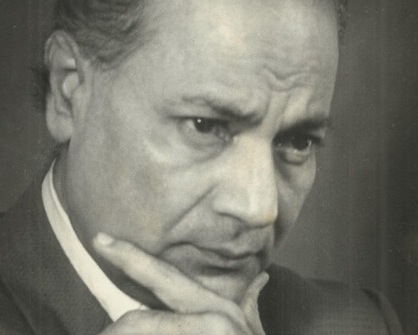Mahesh Kaul was a prominent writer-director-actor, who worked in the Hindi Film Industry.
Kaul was born on April 10, 1911 in Jodhpur. He did his his education from Moni College, Nagpur and initially worked as a jourmalist and was even the branch manager of a bank. He entered films as a lyricist and a dialouge writer and made an early mark when he first acted in Naya Sansar (1941) made at Bombay Talkies starring Ashok Kumar and Renuka Devi. The following year he acted in Debaki Bose’s Hindi/Marathi bilingual Apna Ghar/Aple Ghar (1942) and then made his first film as a director, Angoori (1943). He followed this up with Paristaan (1944), a fantasy, starring Pahari Sanyal.
As a director, Kaul’s breakthrough film was Gopinath (1948), starring Raj Kapoor and well-known IPTA actress, Tripti Mitra. The film is a tragic tale of Gopi (Tripti Mitra) a village woman who is virtually abandoned in the house of Mohan (Raj Kapoor) and his mother. A lower caste woman, she starts loving Mohan. But Mohan loves filmstar Neela Devi (Latika). The film is known mainly for Tripti Mitra’s extra-ordinary performance as the story vindicates tradition being stronger to the liberated but hollow world of the film star. Gopinath was, in fact, a highly critically acclaimed film for Kaul all over. Even the hard-to-please Baburao Patel (of Filmindia fame) was all praise for the film.
Followed a period where Kaul stuck only to directing. His next film after Gopinath was Naujawan (1951), perhaps his most well-known and popular film starring Nalini Jaywant, Premnath and Nawab. The fluffy film, lightweight by Kaul’s standards, is still remembered for the evergreen ditty, Thandi Hawaen Lehrake Aayen, composed by SD Burman and sung by Lata Mangeshkar. The song was an early Sahir Ludhianvi hit.
Other films he directed include Jeewan Jyoti (1953), the first film Shammi Kapoor shot for even if Rail Ka Dibba (1953) released first, Abhiman (1957), made at Filmistan, Aakhri Dao (1958) starring Nutan and Shekhar and Talaq (1958), an early Rajendra Kumar starrer, which he produced as well. While Abhiman and Aakhri Dao were primarily entertainers, Talaq was a critically acclaimed film. It looks at the marriage between a school teacher (Kamini Kadam) and a poet-engineer (Rajendra Kumar) that comes under stress almost leading to a divorce. Talaq was nominated for the Filmfare Awards for Best Film and Kaul for Best Director, but lost out to Madhumati and Bimal Roy respectively. Other films Kaul produced include Santan (1959) – with his Talaq pair of Kasam and Kumar, and Miya Bibi Razi (1960).
Kaul returned to acting in Guru Dutt’s Kaagaz ke Phool (1959) playing Guru Dutt’s westernized father-in-law, Sir BB Verma, modelled clearly on Baburao Patel. Unfortunately, his scenes were among the weakest in the film with Guru Dutt treating his wife’s family as total cardboard caricatures. Kaul would thereafter act in just one more film, the Vijay Anand directed Tere Mere Sapne (1971).
He did return to directing (and producing), though, with Pyar Ki Pyas (1961), India’s first cinemascope film in color. The film looks at how parents (Nishi, Shreekant) neglect their adopted child (Honey Irani) after they have their own biological child. Kaul followed Pyar Ki Pyas by making perhaps his most critically successful film outside of Gopinath, Sautela Bhai (1962). Quoting the Filmfare review of the film, based on Sarat Chandra Chattopadhyay’s Baikunther Will, “When most of our producers are fumbling with formula films, Alok Bharati’s Sautela Bhai’s Chandra comes like a breath of fresh air. A story of two step-brothers, the elder one a good hearted rustuc and the younger an educated weakling spoiled by his crooked friends, ‘Sautela Bhai’ presents pleasant vignettes of human values and cultural dignities.” The film is also known for Guru Dutt’s best ever performance as an actor. Incidentally, both Pyar Ki Pyas and Sautela Bhai were recognized at the National Level, the former winning a Certificate of Merit (3rd Best Hindi film) and the latter, the All-India Certificate of Merit (3rd Best Indian Film).
Diwana (1967), also produced by Kaul and 5 long years in the making, and Sapnon ka Saudagar (1968) – both re-uniting him with Raj Kapoor – made no major impact even if the latter boasted of introducing ‘dream girl’ Hema Malini after Vyjayanthimala backed out of the film. In fact, Kaul was known for introducing and encouraging new talent. He was among the first to sign Raj Kapoor (Gopinath), Shammi Kapoor and Chand Usmani (Jeevan Jyoti), gave Rajendra Kumara major break as solo hero with Talaq, a film wherein he also introduced actress Kamini Kadam to Hindi audiences. He also launched Sanjeev Kumar as a solo hero with Hum Kahan Ja Rahen Hai for Filmistan but creative differences made him leave the film as the producers were unhappy with Sanjeev Kumar and after Kaul’s exit, they re-shot the film, replacing him! Nitin Bose completed the film.
Kaul made Rakhi Rakhi (1969) for the Film Institute of India, where he also taught, and his last film Agni Rekha starring Sanjeev Kumar and Sharadha was released posthumously in 1973 as Kaul had passed away the previous year on July 2, 1972 and was, in fact, completed by its editor, Hrishikesh Mukherjee.
Kaul’s nephew, Mani Kaul, was also a well-known filmmaker and an important part of the Indian New Wave.
Header photo courtesy Roopesh Kaul.



Fortunately Alok Bharti’s Sautela Bhai(1962) was dream project of my father late Shri Arjun Joshi as co producer of film with their friends.
Hi. We should connect. I am Mahesh Kaul’s son.
Hii
Do you have mahesh sir’s agni rekha upnyas